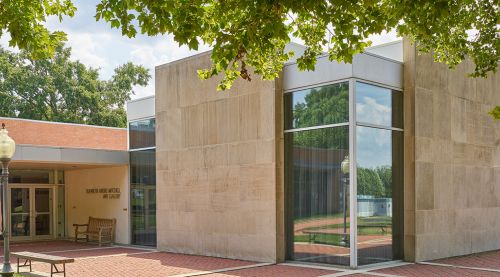
Browse the archive of past exhibitions, or watch recorded presentations from the Mitchell Art Museum.
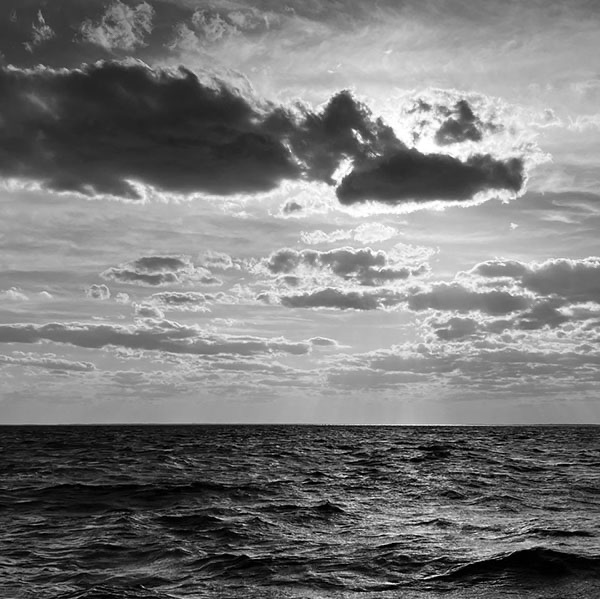
September 18–December 7, 2025
The Question: “Can art save us?”
The sea can be a merciless foe. It is also a poignant metaphor for the human psych. This exhibition tells the story of a subject set adrift in more ways than one.
Artworks by Marcel Broodthaers, Luis Camnitzer, Lenka Clayton and Phillip Andrew Lewis, Rose Finn-Kelcey, Felix Gonzalez-Torres, Renée Green, Lonnie Holley, Betsy Packard, and Josef Strau. Co-curated by Peter Nesbett and Shelly Bancroft.
Exhibition on view during the Annapolis Boat Show and Cruisers University.
Thank you to Alexander Gray Associates, New York; Art Bridges, Bentonville, Arkansas; Bortolami Gallery, New York; Andrée Cooke/Estate of Rose Finn-Kelcey; Greene Naftali Gallery, New York; Kadist, Paris/San Francisco; Kate MacGarry Gallery, London; Lonnie Holley Studio, Atlanta; and Marie-Puck Broodthaers, Estate of Marcel Broodthaers, Belgium for graciously assisting with artwork loans.
Photograph by the curators at sea somewhere between the Bahamas and Annapolis.
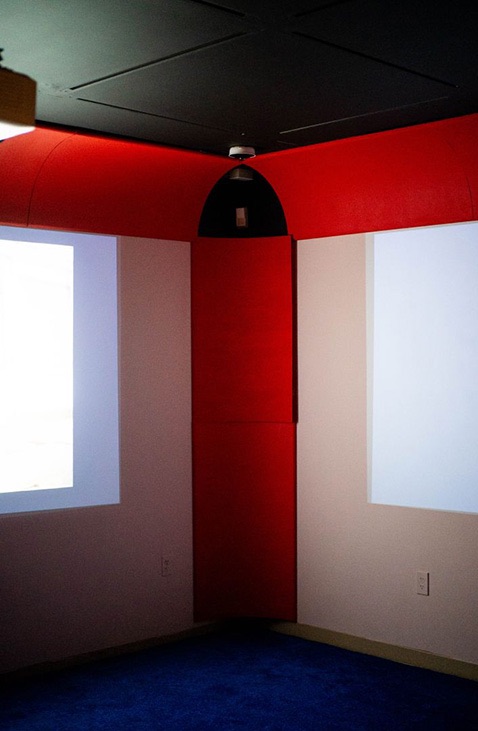
November 5, 2025–February 15, 2026*
The Question: “Who am I to you?”
To inaugurate our new media space, /m is presenting two films from the 1970s by the Cuban-American performance artist Ana Mendieta (1948–1985).
*/m will be closed for winter break from December 8, 2025–January 14, 2026.
Thank you to the Estate of Ana Mendieta Collection LLC and Marian Goodman Gallery.
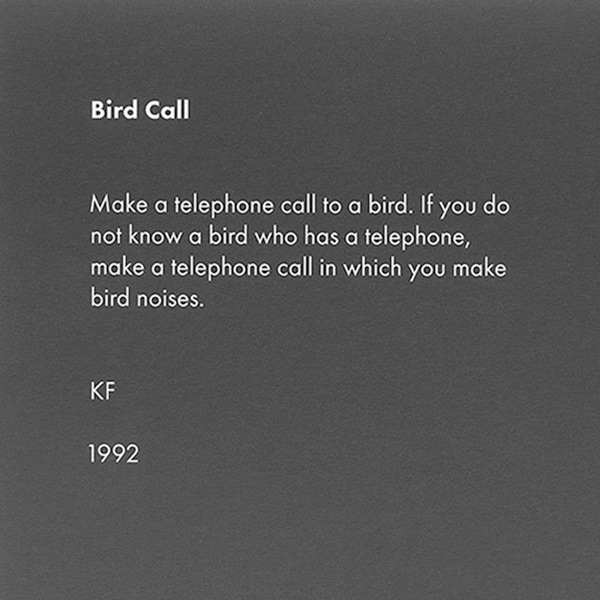
January 15–April 5, 2026
The Question: “What is authorship?”
An exhibition of instructional texts by the American-born, Sweden-based Fluxus artist Ken Friedman. Viewers will be invited to realize the artworks in their minds or in real life.
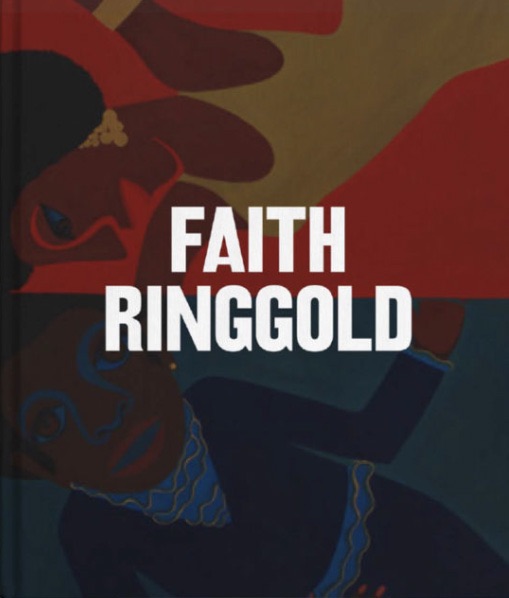
May 2–August 15, 2025 at the Greenfield Library
The Question: “What is the lifetime of an artwork?”
Presenting a selection of beautifully designed artist monographs, this modest exhibition makes a case for how art books not only increase accessibility; they can also extend the lives of artworks, particularly those that are ephemeral. The featured artists are Roni Horn, Faith Ringgold, Fred Sandback, Rirkrit Tiravanija, and Jeff Wall.
Glenstone is a private contemporary art museum in Potomac, Maryland founded in 2006.
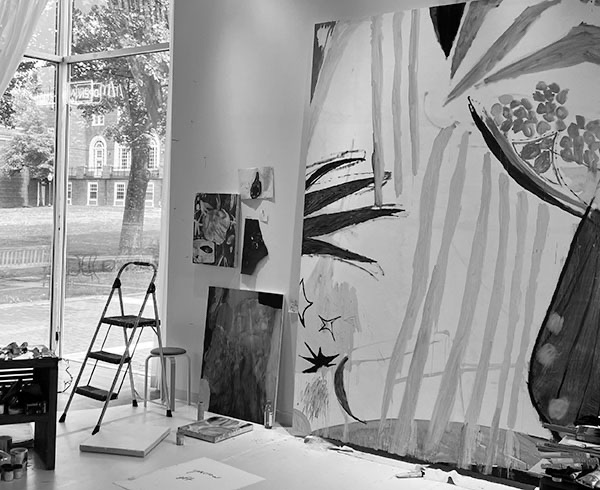
May 2—July 13, 2025
The Question: "Are we ever really finished?"
You have come to see an exhibition. What you have found instead is an active artist’s studio. The difference between the two is important because an exhibition is static— comprising an extant body of work onto which a didactic narrative is often grafted. An artist’s studio, conversely, is a place in formation, where progress is not linear, time splinters and multiplies, and singular narratives dissolve.
For a period of 73 days and nights, the artist r aster syrell is creating art in this room. Her process is the exhibition’s primary subject. Everything is in flux: The drawings and paintings you see today will not look the same in a week. When the exhibition ends on July 13th, she will have a finished body of work, ready—ludicrously, just when it is too late—for an exhibition.
syrell is an observational painter, meaning that she draws and paints what she sees. Here she is responding to the changing reflections in the gallery’s tall corner windows, using the glass in a mode adjacent to how one might deploy a Claude Glass. Plein air painters in the 18th century used dark, handheld mirrors, called Claude Glasses, to capture an image of a landscape that they would then transfer to their canvases. But syrell’s approach is different. First, she thinks of “observational painting” in broad terms, allowing for the inclusion of memory alongside sight. Second, these windows are large. Rather than seeking to reduce and control the world she sees in the reflect- ions, she is exploring the chaotic, rupturing, reflective translucence of the windows themselves. She layers this slowly changing constellation of image-objects into her canvases to activate myriad temporalities. In working this way, she is pushing back against a particularly structured and commodified view of time and space born with the advent of Capitalism.
Queer and trans discourses often describe time in anti- or para-Capitalist terms. It is non-linear, full of shifts, recursions, and discontinuities. This is where the ostensible subject of this exhibition (a non-linear artistic process) and the painting’s actual content (the complex experience of being in the world) intersect. It is also what fuels the metaphor in the exhibition’s title, “Approaching the Garden”. Think of it as a search for a truth or ideal comprised of paradoxical realities, one that is likely unattainable but worth the pursuit.
r aster syrell teaches at St. John’s University in New York and Anne Arundel Community College in Maryland. This exhibition is presented on the occasion of Arundel County Arts Month, Paint Annapolis, and Pride Month.
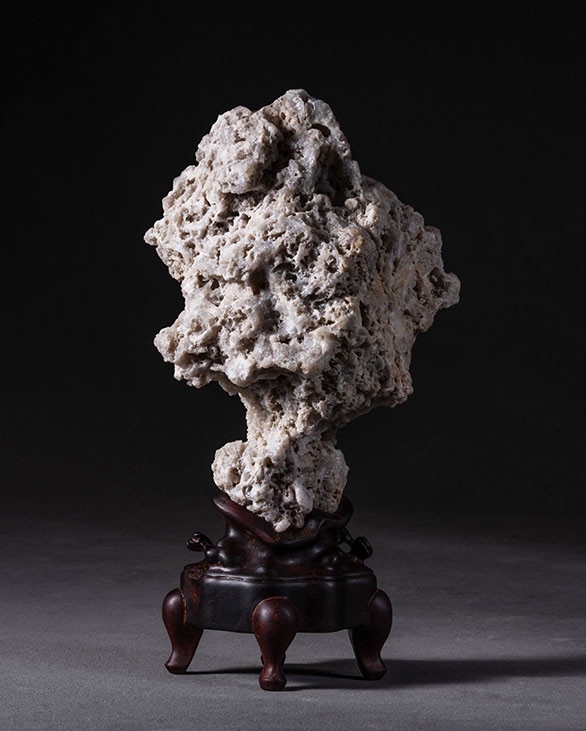
Image credit: Collection of the National Bonsai & Penjing Museum at the U.S. National Arboretum in Washington, D.C. Photo credit: Stephen Voss.
January 23–April 6, 2025
The Question: “Can nature make art?”
Nature’s Readymades presents an extraordinary selection of gongshi (scholars’ rocks or viewing stones) drawn from the National Bonsai & Penjing Museum in Washington, D.C. Carved by nature and relished by Chinese literati as early as the Tang dynasty (7th c.), these paradoxical objects are worlds in miniature, presenting the vital energy of the universe in a hardened, static form. Not sculpted in the conventional sense, they predate Marcel Duchamp’s readymades by more than a millennium, and in many ways pose an even greater challenge to long-held definitions of art: they are unauthored and typically undated, yet have long been understood and appreciated in artistic terms. Government officials steeped in poetry, literature, and art displayed them prominently in their studios, alongside brush and ink paintings.
In addition, the exhibition includes contributions from a range of scholars—a geologist, a novelist, an observational painter, two poets, a political scientist, a religious studies professor, and a sculptor—who each offer thoughts on a rock or stone in their personal possession. The participants include artist Ellen Altfest, who has spent the last eight months looking at and making a painting of a rock, and Ugo Rondinone, whose sculpture has been inspired, in part, by gongshi.
A core question the show asks is, “Is there art in nature?” A related question is if nature can make art.
Co-curated with Shelly Bancroft. Research support by Anita Therese Kent (AGI26) and Faith Chang (A25)
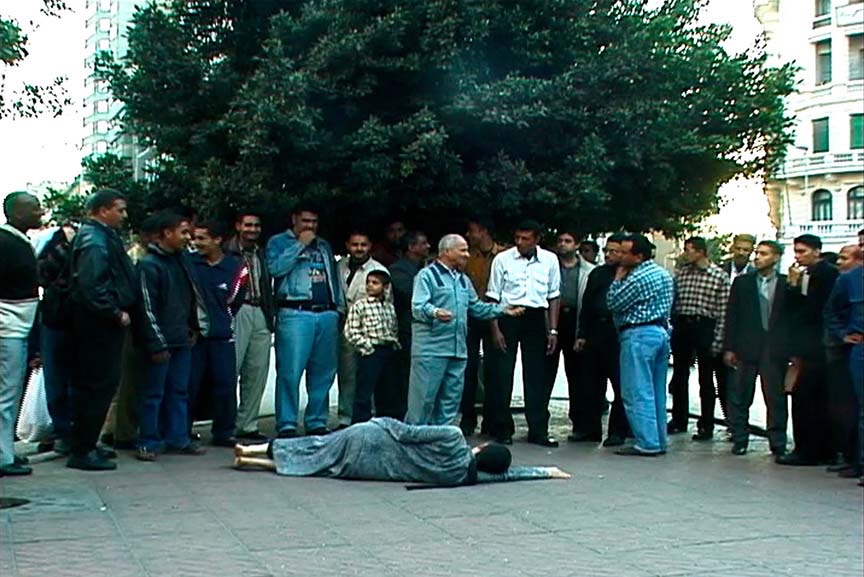
January 23–April 6, 2025
The Question: "What is alive?"
Born in Taegu, Korea, Kimsooja works nomadically but maintains studios in New York, Paris, and Seoul. Her art frequently focuses on migration, displacement, and belonging.
This video, made in 2001, documents Kimsooja performing in her personae the Homeless Woman. It is one of many artworks in which she lies, sits, or stands motionless in a busy metropolis. "My body becomes like a stone on the street," she has said.
Kimsooja practices a principle of "non-doing" and "non-making". She intends to make aware what already exists without the intent of making it.
Special thanks to Kimsooja Studio and Tanya Bonakdar Gallery for lending this artwork.
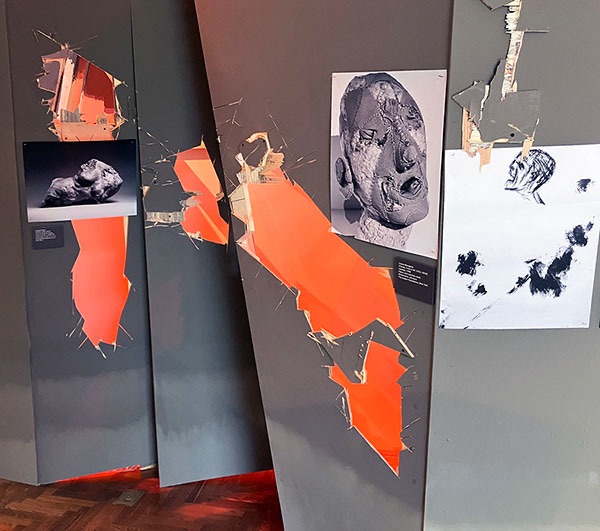
September 14–December 8, 2024
The Question: "Do we live in extraordinary times?"
The history of art is filled with images of chaos and turmoil. Some—of famous battles or revolutions—commemorate real events. Others depict mythic stories by Homer and others handed down through the centuries. Still others visualize the more troubling aspects of daily life, such as fatal accidents or domestic violence.
This exhibition of reproductions from the Baroque to the present—featuring Gentileschi, Géricault, Goya, and many others—is intended to stimulate conversation on the role of such images in art, how these artworks reflect the anxieties of life, and the pyscho-emotional impacts both have on us. We've also included a few images of damaged cultural artifacts from antiquity. These are to remind us that artworks not only depict violence and abuse but are also subject to it, and the inscription of their interactions with the world changes the way we see them.
Why reproductions? The use of copies—prints, plaster casts, paintings—for study in educational and museum settings has a long history. Copies provided ready access to great artworks that were otherwise unavailable. The widespread development of high-quality photomechanical technology in the mid-20th century largely put an end to this practice. A museum without walls emerged in the form of printed art books.
"I would like to write a book which would drive men mad, which would be like an open door leading them where they would never have consented to go, in short, a door that opens onto reality."
—Antonin Artaud
Co-curated with Shelly Bancroft; Co-designed with Bohl Architects, Annapolis/Hudson, NY; Audio installation by Zachary Konick, Annapolis; Research support by Hanna Glick (A24); Material support by Rick & Jenny Nelson; Additional support by Laura Ricciardelli and Dave Watt
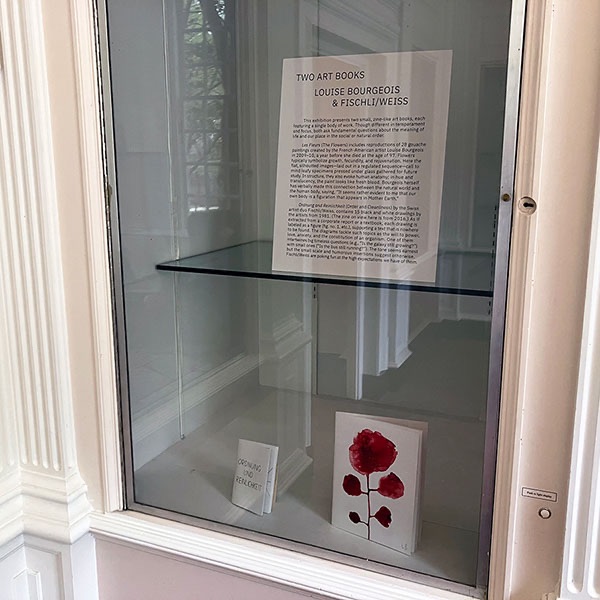
April 19–September 8, 2024
Lillian Vanous Nutt Room, Greenfield Library, St. John's College.
The Question: "What is it to be human?"
This exhibition presents two small, zine-like art books, each featuring a single body of work. Though different in temperament and focus, both ask fundamental questions about the meaning of life and our place in the social or natural order.
Les Fleurs (The Flowers) includes reproductions of 28 gouache paintings created by the French-American artist Louise Bourgeois in 2009–10, a year before she died at the age of 97. Flowers typically symbolize growth, fecundity, and rejuvenation. Here the flat, silhouetted images—laid out in a regulated sequence—call to mind leafy specimens pressed under glass gathered for future study. In structure, they also evoke human anatomy; in hue and translucency, the paint looks like fresh blood. Bourgeois herself has verbally made this connection between the natural world and the human body, saying, “It seems rather evident to me that our own body is a figuration that appears in Mother Earth.”
Ordnung and Reinlichkeit (Order and Cleanliness) by the Swiss artist duo Fischli/Weiss, contains 15 black and white drawings by the artists from 1981. (The zine on view here is from 2016.) As if extracted from a corporate report or a textbook, each drawing is labeled as a figure (fig. no. 1, etc.), supporting a text that is nowhere to be found. The diagrams tackle such topics as the will to power, love, anxiety, and the constitution of an organism. One of them intertwines big timeless questions (e.g., “Is the galaxy still growing?”) with small ones (“Is the bus still running?”). The tone seems earnest but the small scale and humorous insertions suggest otherwise. Fischli/Weiss are poking fun at the high expectations we have of them.
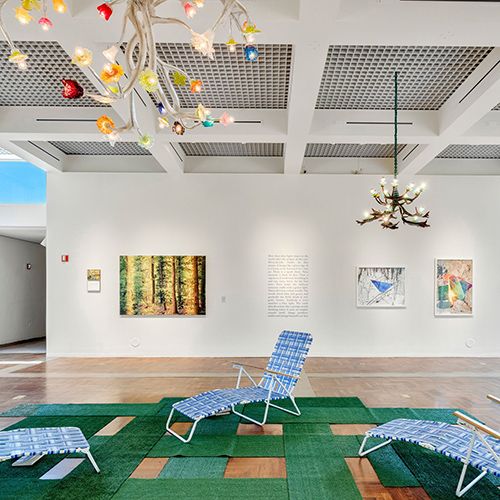
May 4–July 7, 2024
The Question: "What is the quality of our light?"
In this exhibition, artworks by five artists and poetic texts by four writers address the magical, life-making qualities of light. Referenced here are the sun and moon, the stars, an oil lamp, and an electric chandelier. But visual art and literature can be sources of illumination as well. The writer and activist Audre Lorde, writing about “poetry as illumination,” once noted that, “The quality of light by which we scrutinize our lives has direct bearing upon the product which we live, and upon the changes which we hope to bring about through those lives.” The artists and writers include Vija Celmins, Emily Dickinson, Rockne Krebs, Audre Lorde, Virgil Marti, Eileen Myles, Eileen Neff, and Virginia Woolf, and Bahar Yürükoğlu.
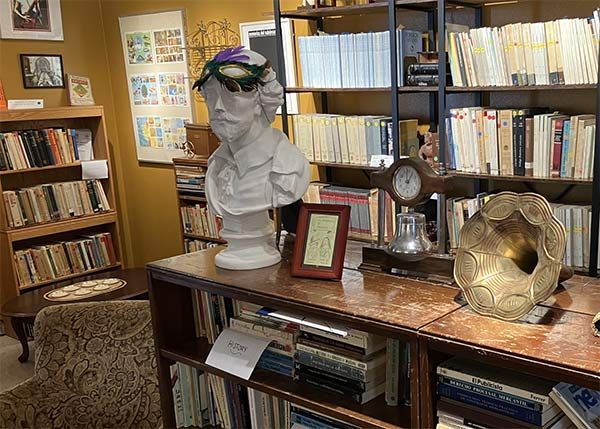
September 30, 2023—April 21, 2024
The Question: "Can art be bound?"
This exhibition, which takes the form of a used bookstore, crammed with a world’s worth of Spanish-language titles. Artist Pablo Helguera created Librería Donceles in Brooklyn 10 years ago to serve the growing Hispanic and Latinx communities in New York. Since then, the bookstore has traveled to more than a dozen cities, becoming a vibrant hub of activity in each.
On December 8-9, 2023, /m brought together the founding artist, arts educators, and musicians for a 10th-anniversary celebration. The weekend included two workshops, a panel discussion, a performance, and a traditional Mexican Posada.
Artist travel supported, in part, by the Mexican Cultural Institute, Washington, DC. Presented in partnership with OHLA (Organization of Hispanics/Latin Americans of Anne-Arundel County).
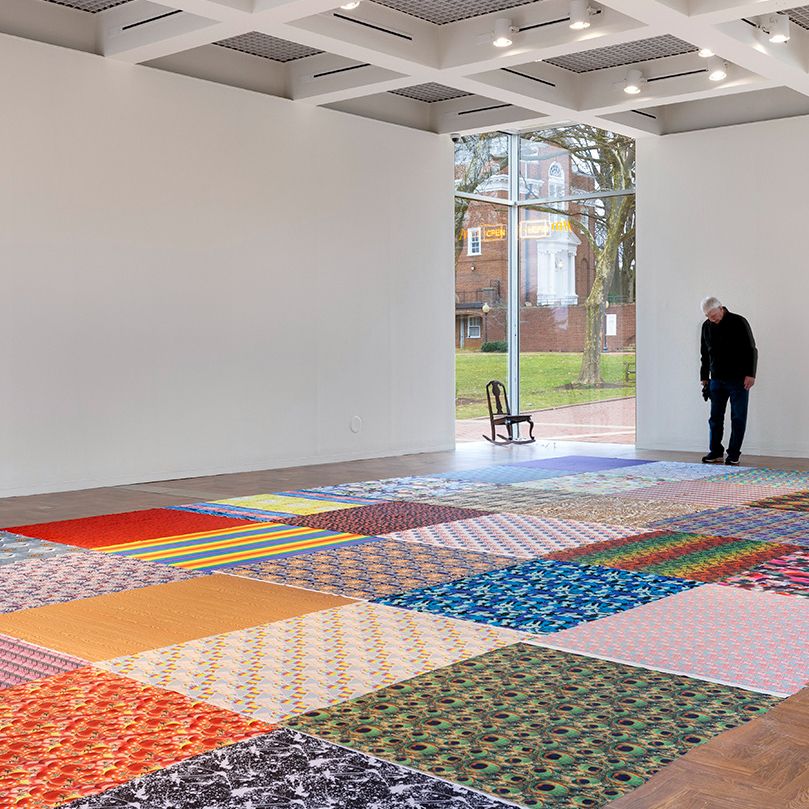
January 20–April 21, 2024
The Question: "Why do we look down on art?"
A critique of judgment is at the core of New York-based artist Polly Apfelbaum’s work, which comprises textiles, and, as of late, ceramics. At /m, she is creating a new installation of unaltered, commercially produced fabrics laid out in a grid on the floor.
The installation is an evolution of her well-known “fallen paintings,” which are in the collection of the Museum of Modern Art and the National Museum of Women in the Arts. Experiencing “Sampling a Sampler Sampling,” we are forced to look down, literally, on artwork that encompasses design, craft, and traditional women’s work. Any superiority one feels, however, is quickly undermined when we realize that the single artwork, light as it is, asserts a claim to the entire gallery while we, the viewers, stand with our backs against the wall. The installation poses several questions, among them, “What is order?” “What is originality?” “What are the bases of our judgments?” and “What do we look down on?”
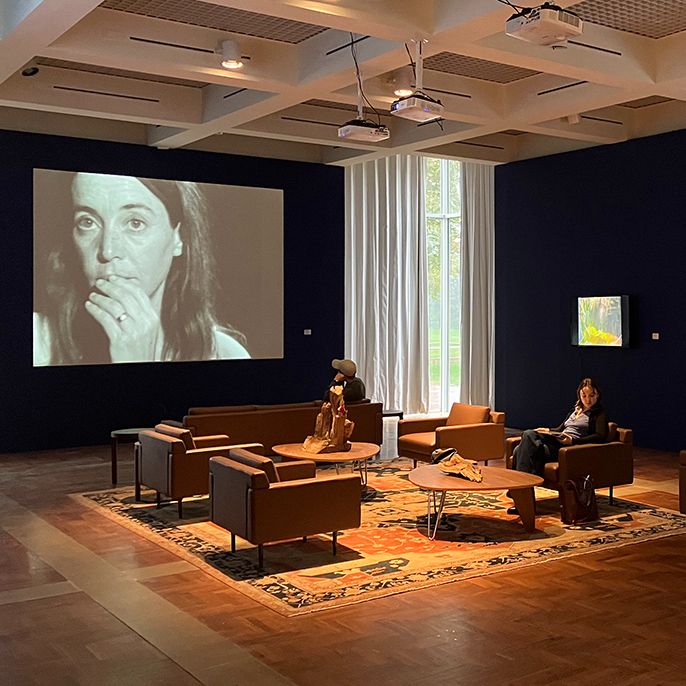
Image credit: Courtesy Electronic Arts Intermix (EAI), New York.
October 14–December 10, 2023
The Question: "Is time elastic?"
Including art by Vito Acconci, Eleanor Antin, Barbara Hammer, Gary Hill, Joan Jonas, Gordon Matta-Clark, and Nam June Paik
In the 1960s, happenings, minimalism, and performance art introduced the concept of time into contemporary art. But it wasn’t until artists started experimenting with technology, using such tools as computers, Kodak Super 8 cameras, and Sony Portapak video cameras, that time was inscribed as a new dimension in visual art, appearing in lieu of inches on museum labels. This exhibition unites pioneering work by seven artists who experimented with the elastic, symbolic, emotional, and social aspects of this ever-elusive subject, while probing the new art’s changing expectations of the viewer.
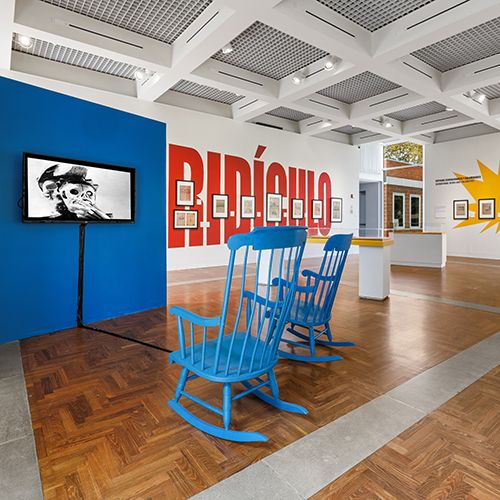
July 21–October 1, 2023
The Question: "Does one have to be serious to be taken seriously?"
An extraordinary collection of work by the artist who Mexican muralist Diego Rivera deemed the “guerrilla fighter of the broadsheets.” The exhibition asked, “Does one have to be serious to be taken seriously?
Curated in consultation with artist and educator Pablo Helguera.
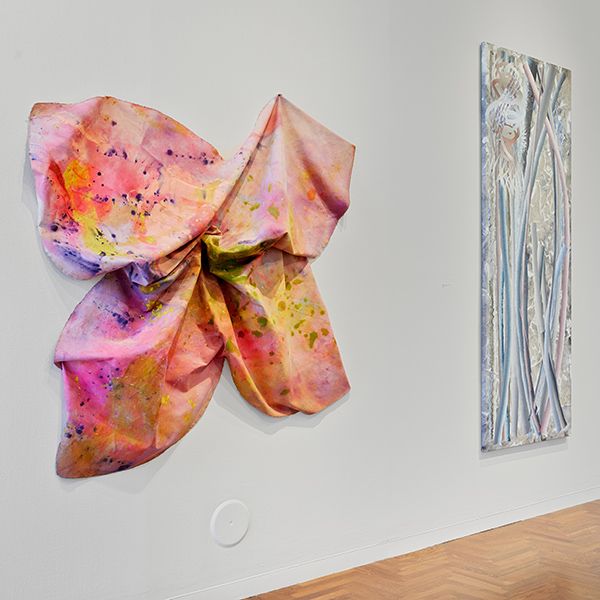
April 9–July 5, 2023
The Question: "What is the political efficacy of friendship?"
Forty paintings, drawings, sculptures, and prints from the collection of pioneering Los-Angeles-based art dealer, including works by Charles Alston, Romare Bearden, Mark Bradford, Elizabeth Catlett, Sam Gilliam, Jacob Lawrence, and Betye Saar. Kebede befriended almost all the artists in her collection in an effort to create a Black collector base for Black artists. Among other questions, the exhibition asked, “What is the political efficacy of friendship?”
Co-curated with Bentley Brown.
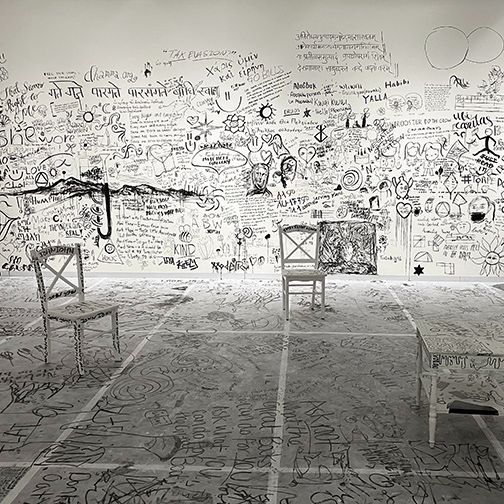
February 17–March 26, 2023
The Question: "What is a museum?"
We reopened after a three-year closure by inviting the public into an otherwise empty museum and asking them to make their mark directly on the clean, white walls. Over the course of five weeks, a cacophony of doodles, diagrams, drawings, and texts filled the space, resulting in an extended portrait of the Mitchell Art Museum’s community. The exhibition was the analog denouement of Pontus Hultén’s concept of the Open Museum and asked, “What is a museum?”

Browse the archive of past exhibitions, or watch recorded presentations from the Mitchell Art Museum.